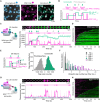Single-molecule analysis reveals the mechanism of chromatin ubiquitylation by variant PRC1 complexes
- PMID: 40397729
- PMCID: PMC12094234
- DOI: 10.1126/sciadv.adt7013
Single-molecule analysis reveals the mechanism of chromatin ubiquitylation by variant PRC1 complexes
Abstract
Chromatin regulation relies on "writer" enzymes that add posttranslational modifications to histone proteins. Variant polycomb repressive complex 1 (PRC1) exists as several subtypes, which are "writers" of ubiquitylation on histone H2A K118 and K119, crucial for transcriptional repression during development and cell identity determination. The mechanism by which dynamic chromatin exploration by variant PRC1 complexes couples to ubiquitin writing is unknown. Here, we developed a single-molecule approach to directly observe chromatin interactions and ubiquitylation by PRC1. We find that variant PRC1 transiently samples chromatin until it reaches a catalytically competent nucleosome-bound state, resulting in E2 recruitment and ubiquitin transfer. Variant PRC1 is weakly processive in ubiquitylating neighboring nucleosomes. Moreover, activity differences between PRC1 subtypes, containing either a PCGF1 or PCGF4 subunit, result from distinct probabilities of achieving a catalytically competent state. Our results thus demonstrate that the dynamic formation of an active complex between variant PRC1, E2, and chromatin is the critical determinant of subtype-specific variant PRC1 activity.
Figures






Similar articles
-
Crystal structure of the PRC1 ubiquitylation module bound to the nucleosome.Nature. 2014 Oct 30;514(7524):591-6. doi: 10.1038/nature13890. Nature. 2014. PMID: 25355358 Free PMC article.
-
Live-cell single particle tracking of PRC1 reveals a highly dynamic system with low target site occupancy.Nat Commun. 2021 Feb 9;12(1):887. doi: 10.1038/s41467-021-21130-6. Nat Commun. 2021. PMID: 33563969 Free PMC article.
-
Synergy between Variant PRC1 Complexes Defines Polycomb-Mediated Gene Repression.Mol Cell. 2019 Jun 6;74(5):1020-1036.e8. doi: 10.1016/j.molcel.2019.03.024. Epub 2019 Apr 24. Mol Cell. 2019. PMID: 31029541 Free PMC article.
-
Activity of PRC1 and Histone H2AK119 Monoubiquitination: Revising Popular Misconceptions.Bioessays. 2020 May;42(5):e1900192. doi: 10.1002/bies.201900192. Epub 2020 Mar 20. Bioessays. 2020. PMID: 32196702 Free PMC article. Review.
-
Mammalian PRC1 Complexes: Compositional Complexity and Diverse Molecular Mechanisms.Int J Mol Sci. 2020 Nov 14;21(22):8594. doi: 10.3390/ijms21228594. Int J Mol Sci. 2020. PMID: 33202645 Free PMC article. Review.
References
-
- K. E. van Holde, “Chromatin” in Springer Series in Molecular and Cell Biology (Springer-Verlag, 1989).
-
- Luger K., Mäder A. W., Richmond R. K., Sargent D. F., Richmond T. J., Crystal structure of the nucleosome core particle at 2.8 Å resolution. Nature 389, 251–260 (1997). - PubMed
-
- Woodcock C. L., Dimitrov S., Higher-order structure of chromatin and chromosomes. Curr. Opin. Genet. Dev. 11, 130–135 (2001). - PubMed
-
- Jenuwein T., Allis C. D., Translating the histone code. Science 293, 1074–1080 (2001). - PubMed
MeSH terms
Substances
LinkOut - more resources
Full Text Sources

